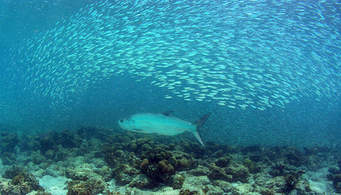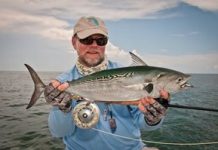For some time now I’ve been fascinated by the claim that fish feeding behaviour is largely influenced by changes in barometric pressure. The fascination started when I read Ronald Reinhold’s book “Predicting the Bite” (ISBN 978-0-578-04734-8) which discusses how to predict when fish will be feeding based largely on changes in barometric pressure. Reinhold is convinced that barometric pressure is responsible for fish feeding activity and has developed a comprehensive set of rules linking barometric pressure to weather patterns and other factors which identifies the “state of ableness” of fish to feed.
While Reinhold obviously put an immense amount of work into developing his rules, they seem to be very specific to his location in the USA and of limited value anywhere else on the planet. I also got the unerring feeling that Reinhold’s theory is predominately based on anecdotal data and not scientific experimentation. He seems to have developed his model based on his diary records and observations and he uses science selectively to reinforce his propositions. It is a powerful dissertation that is unfortunately scant on experimental data analysis.
The problem with Reinhold’s approach is that it seems he was convinced that barometric pressure was central to feeding behaviour from the outset and did not design scientific experiments to prove or disprove his hypothesis. Because of this, his findings are probably flawed due to confirmation bias. Confirmation bias is the tendency to search for, interpret, favor, and recall information in a way that affirms one’s prior beliefs or hypotheses. People display this bias when they gather or remember information selectively, or when they interpret it in a biased way. The effect is stronger for desired outcomes, for emotionally charged issues, and for deeply-entrenched beliefs. People also tend to interpret ambiguous evidence as supporting their existing position.
To confirm my doubts that barometric pressure was central to feeding behaviour I decided to run a 12 month experiment to see if there was any difference in catch rates between the periods Reinhold identified as optimum and the periods which were supposed to be sub-optimal. To cut a long story short, there was no statistically significant difference between catch rates in the optimal and sub-optimal periods. I could find no pattern. For the record, I used a single lure throughout the 12 month period to avoid bias and collect meaningful data. For more details click on:- The single lure experiment

Surprised at the results I then decided to see if I could find an explanation why. During my investigation I found an excellent article in MidCurrent written by Dr. David Ross entitled “The Pressure myth” which provided some insights. Ross writes:-
“FISHERMEN sometimes have ideas or opinions about the marine environment that do not stand up to scientific scrutiny. For example, many anglers believe that changes in barometric pressure strongly influence fish behavior—most notably their willingness to cooperate with anglers. Some have even written that fish can detect a change in barometric pressure before it occurs. An interesting notion, perhaps, though in almost all instances it is incorrect.
A rise or fall in barometric pressure, such as with an approaching cold front, usually means a shift in the weather pattern. And it is the change in the weather, not any fluctuation in barometric pressure, that affects both the fish and the fishing. In fact, most saltwater species probably aren’t even aware of barometric variations.
Pressure, whether in the air or in the ocean, is expressed by scientists as units of “atmosphere.” One atmosphere is defined as the pressure caused by the weight of all the overlying air at sea level—or 14.7 pounds per square inch (psi). Atmospheric pressure is often called barometric pressure because it can be measured by the height of the mercury column in a barometer. Changes in barometric pressure, therefore, indicate capricious weather. In general, low-pressure systems bring unstable conditions, often with precipitation and clouds. A rising barometer means high-pressure is approaching, the harbinger of stable and clear skies.
How much do fish respond to these day-to-day fluctuations? Consider that a normal value for barometric pressure is about 30 inches. Strong high pressure is about 30.70 inches. A powerful low, such as during a hurricane, can reach down to 28 inches or less. The difference between these two extremes (2.7 inches of barometric pressure) is equal to about .09 atmospheres. The barometric pressure difference from a simple passing cold front is only about .06 atmospheres.
The rate of a falling barometer also tells us how fast a low-pressure storm is approaching. A slow-moving storm would have a dip of about .02 to .03 inches of barometric pressure per hour; a fast-moving storm will drop the barometer about 0.05 to 0.06 inches per hour. Simply stated, barometric pressure does not change quickly enough to magically turn the bite on or off. It certainly is one of the ingredients in the overall weather process, but temperature, cloud cover, wind direction and speed, and humidity can also affect fishing conditions. More importantly, the rate and amount of change in barometric pressure is insignificant compared to what’s going on below the surface.
Pressure in the ocean, called hydrostatic pressure, increases with depth due to the weight of the overlying water. Water is almost 800 times denser than air; thus, hydrostatic pressure increases much more rapidly than atmospheric pressure. If you swim or dive just a few feet below the water’s surface, you feel this rapid increase in pressure.
At a depth of just 32.8 feet in the ocean, the hydrostatic pressure is equal to the pressure from the entire weight of the earth’s atmosphere as measured in pounds per square inch. In other words, at 32.8 feet, the total pressure, due to the weight of both the atmosphere and the water, is two atmospheres. At 65.6 feet it’s 3 atmospheres, and so forth. Fish can tolerate hydrostatic pressure because they have a swim bladder containing a volume of gas, which they adjust to equal their environment. This enables most fish to comfortably make small and quick up or down movements in the water column.

In the ocean, four main factors can change the hydrostatic pressure in the fish’s world.
- First, a fish naturally changes pressure around itself by making movements associated with feeding, swimming about, avoiding predators or trying to loose a hook. A small move can result in a relatively large pressure variation. For example, going up or down just 3.28 feet will decrease or increase the pressure on a fish by 1/10 of an atmosphere. One tenth of an atmosphere exceeds any reasonable change that might occur due to a fluctuation in barometric pressure. Equally important, when barometric pressure rises or falls, it can take more than a day to equal the change in hydrostatic pressure that a fish experiences in seconds during its normal up or down movements.
- Second, tides can alter hydrostatic pressure. Assuming the fish stays in the same position, even a small three-foot rise in tide will increase the hydrostatic pressure by about 0.09 atmospheres. A low tide would decrease the hydrostatic pressure by a similar amount. Thus, within about a six-hour period from high to low tide, a fish would experience a fall of about .18 atmospheres of pressure. This is about twice what could be expected from the barometric pressure going through a major drop during a hurricane.
- Third, waves make rapid and continuous changes in hydrostatic pressure. Two-foot waves, for example, will produce a change in pressure of about .06 atmospheres. This rapid change correlates to the period of the waves—about four to six seconds. Higher pressure comes when the crest passes; lower pressure occurs under the trough. When a storm approaches a coastal area, the waves, and the increase in hydrostatic pressure, will be considerably higher than during calm-weather periods.
- The weight of the air itself is the fourth influence on hydrostatic pressure, but its effect is quite gradual. Barometric pressure associated with a major storm will dip (depending on the system’s rate of speed) by only .002 to .02 atmospheres per hour. This gives fish considerable time to make any necessary adjustments. When compared to the effects of the tide, waves, and normal movements of the fish in the water column, changes in hydrostatic pressure caused by barometric-pressure are trivial for saltwater fish. Even a dramatic change in the barometer will be lost to the everyday pressure changes experienced by fish under normal oceanographic conditions.
It’s a happy notion that one could simply consult the mercury column each morning to know whether it’s a better day for work or fishing, but it’s unlikely that barometric pressure alone can trigger the sudden bite that angling’s common wisdom often asserts”.
I also discovered an excellent article by Fisheries Scientist, Ralph Manns, at In-Fisherman.com entitled Barometric pressure and bass which also challenges “one of the most persistent myths in fishing is that barometric pressure controls the activity of bass and other gamefish”.
Manns states that “Although many researchers have tried, scientific studies have been unable to demonstrate that such a relationship exists. Every scientific report we’ve seen, in which barometric pressure was studied, reached a similar conclusion: no direct relationship is evident. This consistency results mainly because no way has been found to isolate barometric pressure influences from simultaneous weather phenomena. We need observations of fish behavior when air pressure changes are the only variable. But significant barometric changes are rare without accompanying changes in wind, temperature, and sky conditions.

The typical weather front is preceded by dropping barometric pressure and increasing cloudiness, while postfrontal conditions usually are clear skies, bright sunlight, and higher air pressure. Although barometric pressure might directly trigger gamefish responses, no mechanism for detecting these changes has been seriously postulated by scientists”.
Manns goes on to describe his field studies in detail and provide some excellent interesting insights into the possible relationship of barometric pressure, weather, and bass behavior namely:-
- When we evaluated actual strikes and refusals of lures presented to bass observed by trackers and divers, we found 52 percent of the bass struck lures during lows compared to only 39 percent during highs. But the vast majority of our strikes took place when the barometer reading was neither particularly high nor low (between 29.30 and 29.70). High or low barometric readings, by themselves, were not consistently indicative of bass activity or catchability.
- When the barometer was falling slowly (less than 0.21 inch per hour), 65 percent of the bass that were presented lures struck, while 35 percent did not. On a slowly rising barometer, only 30 percent struck, while 70 percent didn’t. But our fishing sample was small. The data is confounded by other factors, however. For example, 32 percent of feeding events occurred on solunar majors, only 20 percent on minors, and 27 percent between majors and minors. So solunar influence and other factors may have affected the barometric data. These results don’t necessarily mean that falling barometers increase fishing success or that rising barometers increase offshore activity.
- Barometric pressure changes didn’t provide a positive clue to bass location relative to cover.
- Our bass apparently found little difference between partly cloudy and clear daytime skies, but most likely moved offshore under bright sunlight. Feeding was seen under overcast (42%), broken (23%), scattered (24%), and clear skies (28%). While overcast skies were clearly associated with increased feeding, clouds, even a broken ceiling, had little effect.
- The low light of heavy cloud cover apparently makes prey fish more vulnerable to predators and encourages bass activity. Surprisingly, we documented slightly more feeding activity under totally clear skies than under partial clouds. The maximum brightness of clear skies, which creates optimum feeding opportunities for plankton-eating prey, likely encourages maximum prey fish activity, which in turn may stimulate increased predation.
- When we analyzed the relationships between weather trends and bass proximity to cover, no trends appeared. Virtually the same percent held close to cover before and after a frontal passage, though more were found in cover after the front passed. Bass behavior seems determined by many variables, with no single factor like barometer reading, barometric change, sky condition, wind speed, wind direction, or even prey availability compelling bass to be active or inactive.
- Apparently, the only sure biological fact is that adult bass that have recently fed heavily and are digesting food tend to be inactive or neutral regardless of any environmental factor, including barometric conditions. The length of time since many of the bass in an area fed heavily and the time required to digest that meal are perhaps the most important clues to when a significant proportion of any bass population will next become active.
The last point above is probably the most important of all. If a fish is full then it does not matter what is happening to the barometric pressure it will not be inclined to feed actively. Fish digestion takes much longer than fishermen realise and is heavily influenced by temperature. If the temperature is sub-optimal then it can take days, sometimes weeks, to digest prey which explains why fish in winter are so torpid. I recently wrote an article for AANZ on how fish digestion influences feeding behaviour and this quantifies the effect of temperature on digestion. Click on the following link to read it:- Fish digestion and how it drives feeding behaviour
In summary, there are many factors which govern when fish feed and barometric pressure alone is not an accurate predictor. The science seems to suggest that fish digestion rates, water temperature, weather patterns, water clarity and solunar phase all contribute to when and how aggressively fish feed so it is a wise strategy not to rely on any single indicator. The best plan is to fish as often as possible, even when the conditions and indicators may not appear conducive to fishing. Confining your outings to days when the conditions are “barometrically ideal” means you are missing out on many opportunities.
- The Neil Blog… - July 26, 2023
- The Catfish - July 26, 2023
- update - July 22, 2023











